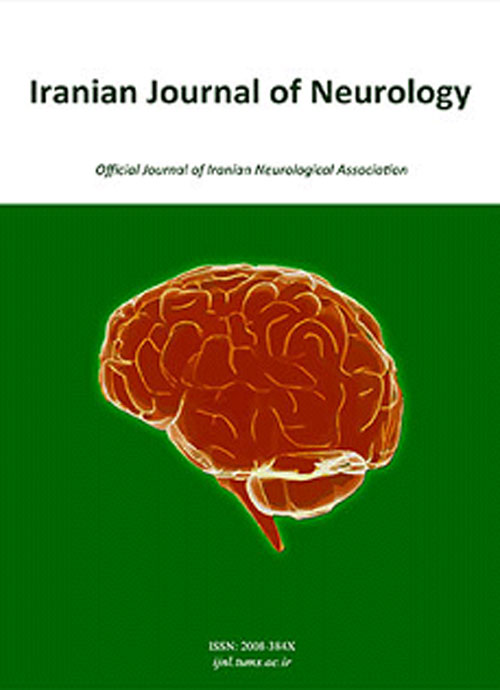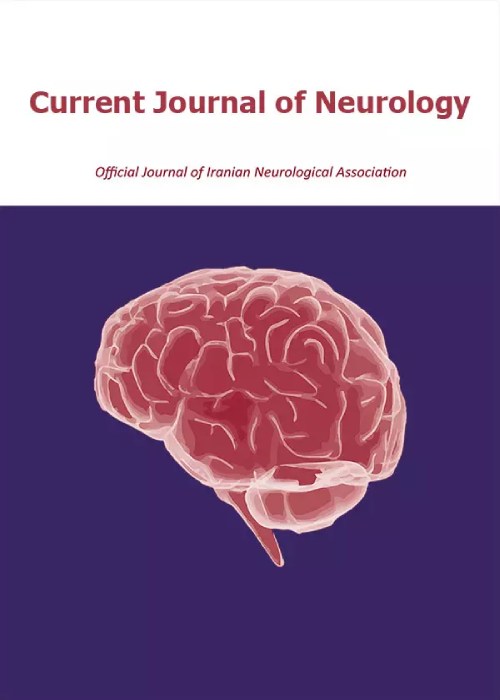فهرست مطالب

Current Journal of Neurology
Volume:17 Issue: 4, Autumn 2018
- تاریخ انتشار: 1397/08/14
- تعداد عناوین: 10
-
-
Pages 154-160BackgroundOne of the demyelinating and inflammatory diseases of the central nervous system (CNS) is multiple sclerosis (MS). Though pathogenesis of MS is still unknown, both genetic and environmental factors are involved. The human leukocyte antigen (HLA) class-II alleles including HLA-DRB5*01, DQB1*0602, DRB1*1501, and DQA1*0102 may have remarkable effect in MS risk although it is controversial in studies. As there is no data with respect to the HLA-DRB1*1501-DRB5*01 correlation with MS in Khuzestan Province, Iran, the goal of the survey was to investigate the association of this haplotype with MS in this population.MethodsThe study focused on DRB5*01-DRB1*1501 haplotype association with MS in 200 patients and 200 healthy individuals. Typing of HLA was carried out by polymerase chain reaction (PCR) amplification with sequence-specific primers (SSP) method. SPSS software was used for the statistical analyses.ResultsNo association between DRB5*01+-DRB1*1501+ and MS was found (P = 0.156). Distribution of DRB1*1501+-DRB5*01- (carrying DRB1*1501+ but not DRB5*01-) and DRB1*1501--DRB5*01- haplotypes was statistically different between patients and controls (29.73% vs. 11.81%, P < 0.001) and (42.16% vs. 68.50%, P < 0.001), respectively. However, DRB1*1501--DRB5*01+ revealed no association with MS (15.13% vs. 11.81%, P = 0.403). HLA-DRB1*1501--DRB5*01+ was significantly more frequent among female patients with MS (16.19% vs. 6.12%, P = 0.019) and Persian group (17.11% vs. 5.79%, P = 0.027). Positive correlation of HLA-DRB1*1501+-DRB5*01- haplotype with the expanded disability status scale (EDSS) steps from 5 to 10 was observed (62.50% vs. 25.76%, P = 0.026). Moreover, no meaningful association was shown among the haplotypes with EDSS, course of MS, ethnicity, and gender.ConclusionOur findings suggest that DRB1*1501+-DRB5*01- and DRB1*1501--DRB5*01- haplotypes may have positive association with MS risk. Also, this survey indicates that HLA-DRB1*1501--DRB5*01+ is involved in susceptibility of the disease among women and Persians. DRB1*1501+-DRB5*01- genotype frequency may have a key role in MS developing.Keywords: Multiple Sclerosis, Human Leukocyte Antigen-DRB5, Human Leukocyte Antigen-DRB1*1501, Polymerase Chain Reaction, Iran
-
Pages 161-166BackgroundIdiopathic intracranial hypertension (IIH) encompasses patients with elevated intracranial pressure (ICP). Generally, it is difficult to make a differential diagnosis between IIH and co-existing migraine headaches. Thus, this article intends to estimate the prevalence of migraine in patients with IIH and explain the occurrence of new-onset migraine after the diagnosis of IIH.MethodsThe case group included 108 patients with IIH referred to the neurology wards of three university hospitals. A random sample of controls (n = 103) were recruited from patients hospitalized in the surgery and orthopedics ward. A checklist for migraine diagnosis was filled out. Cerebrospinal fluid (CSF) pressure and presence or absence of papilloedema (PE) in the patients and any necessary data were also recorded from the inpatient medical documents. All statistical analyses were done by SPSS software.ResultsThere were 70 (64.80%) and 22 (21.40%) migraineurs in the case and control groups, respectively, and the difference was found to be significant (P < 0.001). In 26 (37.14%) migraine cases in the IIH group, the disorder was diagnosed after developing IIH. Also, there was a past medical history of having migraine in 44 (62.85%) migraineurs. In the fully adjusted regression models, the odds of being affected by migraine in patients with IIH was 6.17 times greater than the controls [odds ratio (OR) = 7.15, 95% confidence interval (CI) = 3.56-14.36, P < 0.010]. The patients’ mean CSF opening pressure was 32.10 ± 1.03 cmH2O and 93 (81.60%) subjects were found to have PE.ConclusionIt was demonstrated that subjects with IIH might have about a 6-time higher likelihood of developing migraine headache than the general population. These considerations can help prevent misdiagnosis of migraine headache as the recurrence of IIH or uncontrolled IIH and subsequent inappropriate management.Keywords: Cerebrospinal Fluid, Headache, Idiopathic Intracranial Hypertension, Migraine, Papilloedema
-
Pages 167-173BackgroundThe diagnostic certainty of medullar tuberculosis (TB) without Pott disease is difficult to establish in a tropical environment with the large group of infectious, parasitic, and systemic myelopathies, despite the increasing availability of magnetic resonance imaging (MRI) data and improvement of biological exploration platforms.MethodsWe retrospectively analyzed the files of 186 patients hospitalized in the Department of Neurology and Neurosurgery of the University Hospital Center of Conakry, Guinea, between 2008 and 2016 for the management of non-compressive and compressive myelopathy. Biological evidence of TB infection was demonstrated for 13 (6.9%) patients.ResultsInfectious clinical picture prior to the development of neurological signs was reported in 11 patients (84.6%). The neurological signs were summed up by the existence of a sensitivo-motor semiology of progressive evolution (100% of cases) with sphincter disorders in 11 patients (84.6%) and a medullary compression symptomatology with a lesion and under lesion syndrome from the outset in 4 patients (30.8%). Medullary MRI revealed an extensive intramedullary hypersignal in 9 patients with non-compressive myelopathy and in 4 cases, the lesions appeared in T1 hypersignal and T2 isosignal were localized. Lumbar puncture (LP) revealed lymphocytic pleocytosis, hypoglucorrhage (0.3 to 0.5 g/l), and leukocytosis.ConclusionThis study reveals a classic clinical, biological, neuroradiological, and evolutionary profile of compressive and non-compressive myelopathies. These results are important for the therapeutic and evolutionary discussion of TB myelopathies for good management.Keywords: Myelopathy, Tuberculosis, Guinea
-
Pages 174-179BackgroundThe human T-cell lymphotropic virus type-I (HTLV-I) is the first identified pathogenic human retrovirus. Breastfeeding has been reported to be the predominant route of vertical transmission of HTLV-I. The objective of this systematic review was to pool and evaluate the data on the transmission of HTLV-I with different infant-feeding practices on children born to HTLV-I-positive mothers. We conducted a systematic review of comparison of HTLV-I transmission risk to breastfed and bottle-fed babies.MethodsWe searched the following databases: MEDLINE, SID, Magiran, and Cochrane Library. The search strategy was limited to articles in English. Initial screening identified 254 citations; of these, 96 potentially relevant articles were identified. After reviewing the 96 full-text articles in detail, 7 reports met the inclusion criteria for this review.ResultsPooled odds ratio (OR) and risk difference (RD) of HTLV-I transmission in the breastfed group compared to the bottle-fed infants were [OR = 3.48, 95% confidence interval (CI): 1.58-7.64, P = 0.0020, Cochran’s Q = 27.7, P = 0.0010, and I2 = 67.5%] and (RD = 17.1%, 95% CI: 7.5%-26.7%, P < 0.0001, Cochran’s Q = 106, P < 0.0001, and I2 = 91.5%). So, we have evidence to support that exclusive breast feeding more than 6 months in comparison to bottle feeding highly increases transmission rate of HTLV-I infection. We have also enough evidence to support that exclusive breast feeding up to 6 months compared to bottle feeding does not increase transmission rate of HTLV-I infection (pooled OR = 0.912, CI: 0.45-1.80; OR: 3.83, CI: 1.80-8.10, respectively).ConclusionThe current meta-analysis showed that short period (less than 6 months) of breastfeeding did not increase risk of HTLV-I infection transmission from mother to child among breastfeeders and more than 6 months of breastfeeding significantly increased the risk of HTLV-I infection. However, our meta-analysis shows that refraining from breastfeeding can decrease the risk of vertical HTLV-I transmission.Keywords: Meta-Analysis, Human T-Lymphotropic Virus 1, Breast Feeding, Breast Milk, Review
-
Pages 180-188BackgroundDysphagia is the most prevalent sign of multiple sclerosis (MS) which can reduce the quality of life and augment mortality in the final stages of MS. We presented a systematic review to estimate the prevalence of dysphagia in general and separately for each evaluation method (subjective and objective), and to analyze the causes of this rampant disease.MethodsCross-sectional and prospective cohort studies were reviewed and scientific proofs were evaluated consistent with the pre-specified levels of certainty.ResultsTwenty-two articles entered the meta-analysis phase; the estimation of the general prevalence of dysphagia in MS-affected patients was 43.33% related to all the 22 studies. Moreover, the estimate of the prevalence via the subjective (16 studies) and objective (6 studies) methods were 37.21% and 58.47%, respectively.ConclusionThis study obtained the prevalence rate of dysphagia in patients affected by MS globally, yet there was infinite statistical society and limited methodological quality. Thus, more extensive studies are required for a better understanding of the global epidemiology regarding dysphagia in MS.Keywords: Dysphagia, Multiple Sclerosis, Prevalence, Systematic Review
-
Pages 189-191BackgroundEight-and-a-half syndrome (EHS) is one-and-a-half syndrome [(conjugated horizontal gaze palsy and internuclear ophthalmoplegia (INO)] plus ipsilateral fascicular seventh cranial nerve palsy. Involvement of lower pontine tegmentum including the abducens nucleus, the ipsilateral medial longitudinal fasciculus (MLF), and the adjacent facial colliculus contribute to the clinical findings of EHS. Recently, nine syndrome with addition of hemiparesis or hemianesthesia to EHS (due to involvement of adjacent corticospinal tract or medial lemniscus) is suggested.MethodsConsecutive patients with presentation of EHS or nine syndrome were reviewed from referral neuro-ophthalmology and strabismus clinics.ResultsThree cases of EHS were identified with different etiologies of intracerebral hemorrhage (ICH), demyelination, and neuromyelitis optica spectrum disorder. Moreover, one case of "nine syndrome" due to ICH was described. Brain magnetic resonance imaging (MRI) in all of them revealed lesion in lower tegmentum of pons.ConclusionApart from different etiologies, recognition of EHS or nine syndrome allows precise localization of the lesion to lower pontine tegmentum ipsilaterally.Keywords: Eight-and-a-half Syndrome, Nine Syndrome, Intracerebral Hemorrhage, Demyelination, Neuromyelitis Optica Spectrum Disorder
-
Pages 195-196


